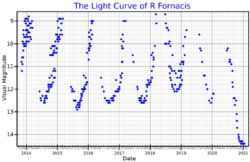Astronomy:R Fornacis
| Observation data Equinox J2000.0]] (ICRS) | |
|---|---|
| Constellation | Fornax |
| Right ascension | 02h 29m 15.308s[2] |
| Declination | −26° 05′ 55.65″[2] |
| Apparent magnitude (V) | 7.5 - 13.0[3] |
| Characteristics | |
| Evolutionary stage | AGB[4] |
| Spectral type | C4,3e[5] |
| Apparent magnitude (J) | 3.82[6] |
| Apparent magnitude (K) | 1.06[6] |
| Variable type | Mira[3] |
| Astrometry | |
| Proper motion (μ) | RA: 8.551[2] mas/yr Dec.: −3.957[2] mas/yr |
| Parallax (π) | 1.8069 ± 0.0358[2] mas |
| Distance | 1,810 ± 40 ly (550 ± 10 pc) |
| Details | |
| Mass | 1.05[7] M☉ |
| Luminosity | 16,904[8] L☉ |
| Surface gravity (log g) | 0.12[7] cgs |
| Temperature | 2,060[8] - 3,130[7] K |
| Metallicity [Fe/H] | 0.21[7] dex |
| Other designations | |
| Database references | |
| SIMBAD | data |
R Fornacis is a Mira variable and carbon star located in the constellation Fornax. It is around 1,800 light years away based on parallax measurements.
R Fornacis is a carbon star, a star on the asymptotic giant branch with an excess of carbon over oxygen in its atmosphere due to fusion products being dredged up to the surface from deep inside the star. It is also a Mira variable, a type of pulsating giant star which varies by several apparent magnitudes with a period of a few hundred days. R Fornacis has a period of 389 days and varies between extremes of magnitude 7.5 and 13.0, although average maximum and minimum magnitudes are 8.9 and 12.2 respectively..[9]
R Fornacis was discovered to be variable in 1896 after it had been observed with a different brightness to that shown in the Cordoba Durchmusterung.[10] In 1983, an unusually deep minimum was observed, and later correlated with an asymmetric shell of material ejected from the surface of the star.[4] Unconfirmed visual estimates of the unusual minimum give a magnitude of 14.0, while infrared observations confirm the unusual variation.[9]
See also
References
- ↑ "Download Data". AAVSO. https://www.aavso.org/data-download.
- ↑ 2.0 2.1 2.2 2.3 2.4 Brown, A. G. A. (2021). "Gaia Early Data Release 3: Summary of the contents and survey properties". Astronomy & Astrophysics 649: A1. doi:10.1051/0004-6361/202039657. Bibcode: 2021A&A...649A...1G. Gaia EDR3 record for this source at VizieR.
- ↑ 3.0 3.1 Samus, N. N. et al. (2009). "VizieR Online Data Catalog: General Catalogue of Variable Stars (Samus+ 2007-2013)". VizieR On-line Data Catalog: B/GCVS. Originally Published in: 2009yCat....102025S 1: B/gcvs. Bibcode: 2009yCat....102025S.
- ↑ 4.0 4.1 Paladini, C.; Sacuto, S.; Klotz, D.; Ohnaka, K.; Wittkowski, M.; Nowotny, W.; Jorissen, A.; Hron, J. (2012). "Detection of an asymmetry in the envelope of the carbon Mira R Fornacis using VLTI/MIDI". Astronomy & Astrophysics 544: L5. doi:10.1051/0004-6361/201219831. Bibcode: 2012A&A...544L...5P.
- ↑ Yamashita, Y. (1975). "The C-classification of spectra of carbon stars. II". Tokyo 15: 47. Bibcode: 1975AnTok..15...47Y.
- ↑ 6.0 6.1 Ducati, J. R. (2002). "VizieR Online Data Catalog: Catalogue of Stellar Photometry in Johnson's 11-color system". CDS/ADC Collection of Electronic Catalogues 2237. Bibcode: 2002yCat.2237....0D.
- ↑ 7.0 7.1 7.2 7.3 Anders, F.; Khalatyan, A.; Chiappini, C.; Queiroz, A. B.; Santiago, B. X.; Jordi, C.; Girardi, L.; Brown, A. G. A. et al. (2019). "Photo-astrometric distances, extinctions, and astrophysical parameters for Gaia DR2 stars brighter than G = 18". Astronomy and Astrophysics 628: A94. doi:10.1051/0004-6361/201935765. Bibcode: 2019A&A...628A..94A.
- ↑ 8.0 8.1 Bergeat, J.; Knapik, A.; Rutily, B. (2001). "The effective temperatures of carbon-rich stars". Astronomy and Astrophysics 369: 178–209. doi:10.1051/0004-6361:20010106. Bibcode: 2001A&A...369..178B.
- ↑ 9.0 9.1 Feast, M. W.; Whitelock, P. A.; Catchpole, R. M.; Roberts, G.; Overbeek, M. D. (1984). "Variable circumstellar obscuration of the carbon star R Fornacis". Monthly Notices of the Royal Astronomical Society 211 (2): 331–337. doi:10.1093/mnras/211.2.331.
- ↑ Pickering, E. C.; Leland, E. F. (1896). "Harvard College Observatory, circular no. 10. Six new variable stars". The Astrophysical Journal 4: 234. doi:10.1086/140271. Bibcode: 1896ApJ.....4..234P.
 |


